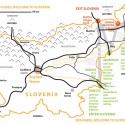Tag: Map of Slovenia
-

Hungary closes its borders
On October 15 2015 Hungary finally decided to close its border passage Botovo with Croatia, where the “more formal coridor” for the flow of people, temporary established by inter-governmental agreements, took place, changing the direction of the so called balkan route. Instead of going through Croatia to Hungary the route is redirected to Slovenia, where…